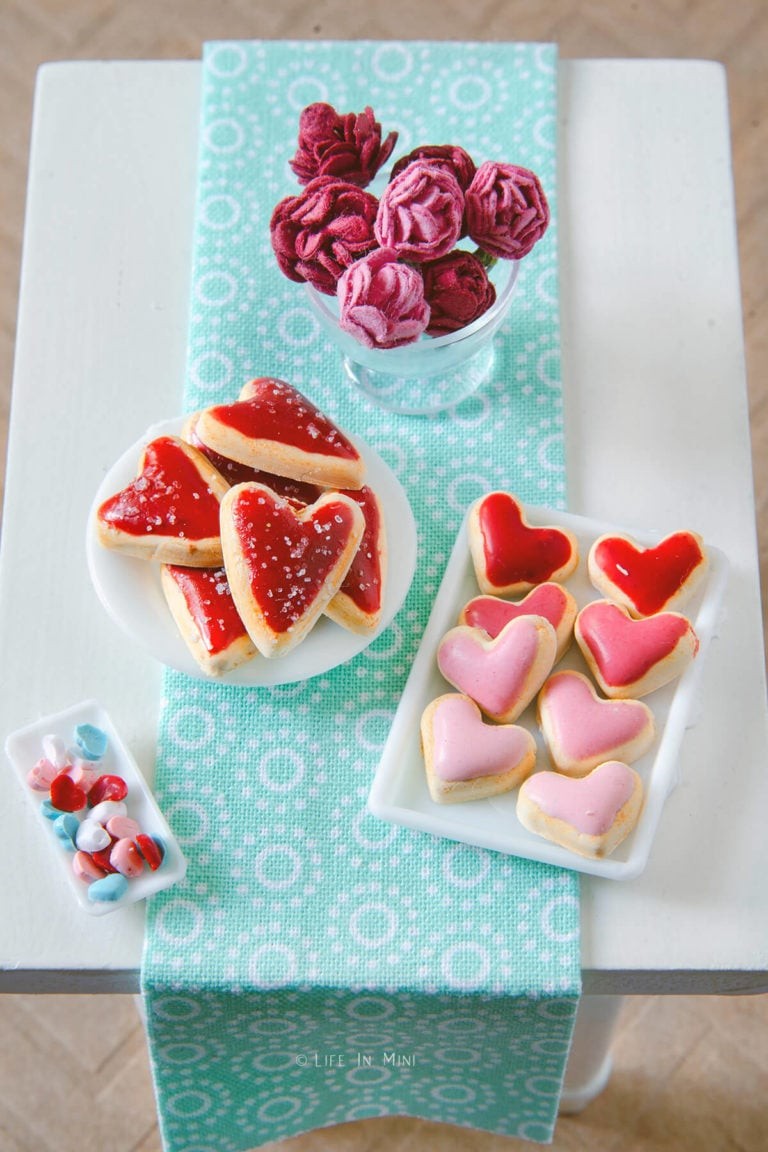Creating Miniature Food is a captivating craft, allowing you to bring tiny, charming edibles to life. Among the myriad of miniature food options, sugar cookies stand out for their delightful appearance and ease of creation, especially when using polymer clay. This guide will walk you through the process of making adorable miniature sugar cookies from polymer clay, perfect for dollhouses, miniature scenes, or simply as charming collectibles. Polymer clay’s versatility makes it an ideal medium for crafting miniature food, and these miniature cookies are a fantastic project for both beginners and experienced crafters.
Polymer clay miniature food offers a fantastic way to unleash your creativity. While mastering miniature bowls and plates can be challenging, crafting miniature foods with polymer clay is incredibly rewarding. If you’re looking for a relaxing and imaginative activity, diving into the world of miniature food creation is a perfect choice.
With Valentine’s Day approaching, the inspiration for heart-shaped miniature sugar cookies is undeniable. While your family might be expecting real baked goods, these miniature cookies will surely delight your miniature family and add a touch of sweetness to your miniature scenes. The beauty of this craft lies in its adaptability; you can tailor these miniature cookies to any holiday or theme you desire, making them a versatile addition to your miniature food collection.
Just like their full-sized counterparts, decorating these miniature cookies is where the real fun begins! Let’s explore the supplies and step-by-step process to create these charming miniature treats.
Essential Supplies for Miniature Food Cookies
To embark on your miniature food cookie crafting journey, gather these essential supplies:
Materials
- Light Yellow Polymer Clay: This forms the base of your miniature cookies, mimicking the color of baked sugar cookies.
- Clear Liquid Polymer: This acts as the “icing” for your cookies, providing a glossy and decorative finish.
- Pastels (Browns and Colors of your choice): Pastels are crucial for adding realistic color and detail. Brown pastels will create the baked edges, while colored pastels will tint your liquid polymer icing.
- Craft Sand (Optional): Fine craft sand can be used to simulate sugar sprinkles for added texture and realism.
Tools
- Rolling Pin: Used to evenly flatten the polymer clay to the desired thickness for your miniature cookies.
- Mini Cutters: These are essential for creating precise cookie shapes. Heart shapes are perfect for Valentine’s Day, but you can use any shapes you like.
- Xacto Knife or Pointy Tool: These tools are useful for adding texture to the cookie edges and for applying the liquid polymer icing precisely.
- Small Paint Brush: A fine-tipped paintbrush is ideal for applying pastel powders to create the “baked” cookie edges.
- Plastic Wrap: Used to cover the clay while cutting shapes, preventing the cutters from sticking.
- Parchment Paper or Foil: For working with pastels and for baking the polymer clay cookies.
Step-by-Step Guide to Crafting Miniature Food Cookies
Follow these detailed steps to create your own batch of delightful miniature food sugar cookies:
Step 1: Prepare and Roll the Polymer Clay
Begin by conditioning your light yellow polymer clay until it becomes soft and pliable. This makes it easier to work with. Once softened, use a rolling pin to roll the clay out to your desired thickness. For realistic miniature cookies, aim for a thickness of about ⅛-1/16 inch.
Step 2: Cut Out Cookie Shapes
Place a sheet of plastic wrap over the rolled-out clay. This prevents the cutters from sticking and ensures clean cuts. Use your mini cutters to press out your desired cookie shapes. Gently pull up the plastic wrap to lift the cutter away from the clay, leaving the perfectly shaped miniature cookies behind.
Step 3: Add Edge Texture (Optional)
For added realism, you can texture the edges of your miniature cookies. Use a pointy tool or the tip of your Xacto knife to carefully scratch and poke small holes around the edges. For a subtler texture, gently brush the edges with an old toothbrush. This step adds a handmade, slightly imperfect look to your miniature food, enhancing their charm.
Step 4: Create “Baked” Edges with Pastels
Use a piece of parchment paper or foil to grate a small amount of brown pastel. Using your small paintbrush, gently brush the edges of your miniature cookies with the brown pastel shavings. This technique mimics the slightly browned edges of real sugar cookies after baking, adding depth and realism to your miniature food.
Step 5: Prepare Colored Liquid Polymer “Icing”
On a fresh piece of parchment paper or foil, grate the colored pastels you’ve chosen for your icing. Add a small amount of clear liquid polymer to the pastel shavings and mix thoroughly with your pointy tool until you achieve your desired icing color and consistency.
Step 6: Ice Your Miniature Cookies
Using your pointy tool, carefully apply the colored liquid polymer “icing” to your miniature cookies. Work in small amounts and take your time to ice cleanly and precisely. Rushing this step can lead to messy results, so patience is key when creating miniature food details.
Step 7: Add Sprinkles (Optional)
If desired, sprinkle a tiny amount of craft sand onto the “iced” cookies to simulate sugar sprinkles. This adds a delightful textural element and extra sparkle to your miniature food creations.
Step 8: Bake the Polymer Clay Cookies
Carefully place your decorated miniature cookies onto a parchment paper-lined baking sheet, a ceramic tile, or a piece of glass. Bake them according to the instructions on your polymer clay package. Baking times and temperatures vary depending on the brand of polymer clay, so always refer to the manufacturer’s guidelines for the best results when working with miniature food and polymer clay.
Tips and Creative Ideas for Miniature Food Cookies
- Ombre Icing Effect: To create the ombre icing effect, start with your darkest icing color and ice a portion of your cookies. Gradually lighten the icing by adding small amounts of white liquid polymer, icing cookies with each lighter shade to achieve a beautiful gradient effect.
- Miniature Cutter Sources: Finding miniature cutters can be an adventure! Craft stores like Michaels often have mini cutter sets, especially in their clay sections. Online marketplaces like Etsy are also treasure troves for unique and tiny cutters specifically designed for miniature food crafting. Look for shops specializing in dollhouse miniatures for the best selection.
- Beyond Sugar Cookies: Once you’ve mastered miniature sugar cookies, explore other miniature food variations! Try making gingerbread cookies, chocolate cookies, or even savory crackers using different colors of polymer clay and creative decorating techniques.
- Holiday Themes: Adapt your miniature cookies for any holiday! Use Christmas tree cutters for festive treats, pumpkin shapes for Halloween, or egg shapes for Easter. The possibilities for themed miniature food are endless.
Crafting miniature food, especially these polymer clay sugar cookies, is a wonderfully rewarding hobby. It’s a chance to exercise your creativity, attention to detail, and patience, resulting in charming and delightful miniature creations. So gather your supplies, follow these steps, and embark on your miniature food crafting adventure today!

